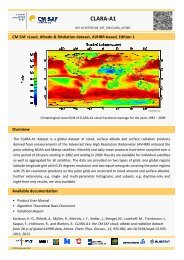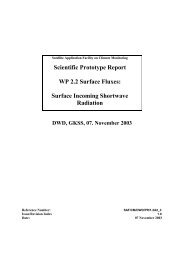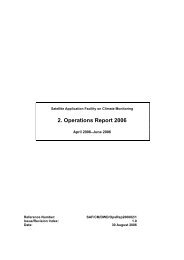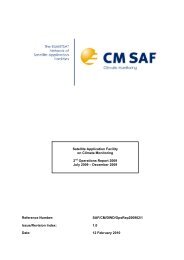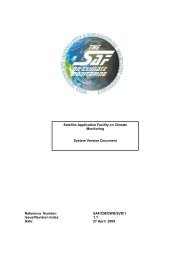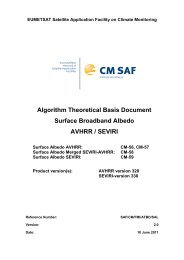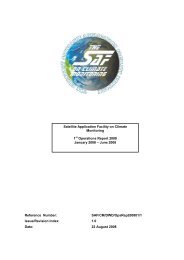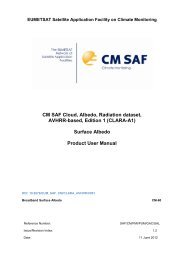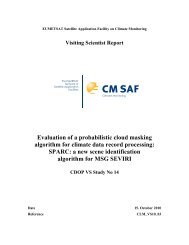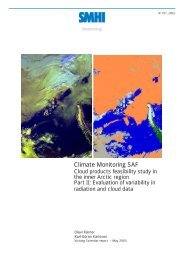Aerosol retrievals from METEOSAT-8 - CM SAF
Aerosol retrievals from METEOSAT-8 - CM SAF
Aerosol retrievals from METEOSAT-8 - CM SAF
You also want an ePaper? Increase the reach of your titles
YUMPU automatically turns print PDFs into web optimized ePapers that Google loves.
<strong>SAF</strong> on Climate Monitoring Visiting Scientists Report Doc. No: 1.0<br />
Issue : 1.0<br />
Date : 4 October 2006<br />
Figure 4: Example of the daily aerosol optical thickness product derived <strong>from</strong> MISR on 14 th of<br />
July 2005. The colour scale ranges <strong>from</strong> 0 to 0.5. source: EOS LARC MISR web server<br />
5.1.3 GOES<br />
The GOES <strong>Aerosol</strong>-Smoke Product (GASP) provides aerosol optical depth <strong>retrievals</strong> over the U.S.<br />
at 4 km spatial resolution and 30 minute intervals. The retrieval is performed over ocean and land<br />
and is available once per day for the full disk of the Earth <strong>from</strong> GOES-East (providing information<br />
for South America). The algorithm is described in Knapp et al. (2002, 2005). The main approach is<br />
to build a surface reflectance reference by selecting, for each pixel, the second darkest image in the<br />
composite time period and then to perform aerosol retrieval over land based on Look Up Tables of<br />
gaseous and Rayleigh corrected reflectance for various surface reflectance and aerosol loading (see<br />
an example of the AOT map over the US East coast for the 19 April 2005 in Fig. 5). The second<br />
darkest pixel is chosen to reduce the effect of cloud shadows (shadowed pixel reflectance is<br />
generally darker than surface -alone- reflectance). The reflectance reference is computed for a<br />
composite time period varying along the year <strong>from</strong> 7 days to 28 days. The length of the time period<br />
depends on the accuracy expected on the reflectance reference. More observations increase the<br />
chance of observing cloud-free and aerosol-free day, but if too many days of observations are used,<br />
the surface reflectance may change. For the eastern US, Knapp et al. found that 14-days period was<br />
a good compromise. The main limitation is that it requires that the TOA reflectances increase with<br />
increasing aerosol loading, and thus it does not work for a combination of bright surface and<br />
- 13 -



